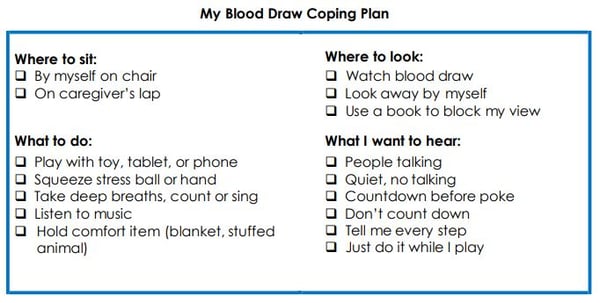Helping Your Child Cope With Blood Draws
Jump to:
How to prepare and what to bring
- Talk to your child about the test.
- You could say something like: There will be a small pinch to get some blood. The blood tells the doctor important information about your body. Your important jobs are to help hold still and to take big breaths. While they are getting the blood, we can play with the tablet.
- Tell them what choices they will have and make a coping plan (see below).
- Watch this video to help prepare: https://childrenswi.org/medical-care/laboratory-services. Caregivers, please watch first to decide if it is right for your child.
- Bring comfort items, toys, or activities from home to use during the blood draw
- For younger children: blanket, stuffed animal, book, toys.
- For older children and teens: toys, fidget item, stress ball or squish, tablet or phone.
- Children’s labs have distractions for different age groups that can be used in the room.
Here are some questions you can ask the person who is drawing the blood
- Are there ways to manage my child’s pain today? (like numbing spray)
- Can my child sit in my lap?
- Do you have any toys or books my child can play with to distract them?
Think about ways to manage the pain
Numb the pain.
o Ask the lab staff if they have the spray to numb the area.
o Put ice packs where they will have the blood draw before it is done.
o Ask your doctor about getting a prescription to use EMLA numbing cream on blood draw sites 30 minutes before getting to the lab. Please be sure to follow instructions from the pharmacist about the right way to use EMLA.
- Hold a vibrating device, like Buzzy, above where the blood will be drawn. Vibrations block pain during a blood draw, shot, or IV.
- Use ShotBlocker. It uses firm bumps to overwhelm the senses around where a poke will be. This confuses the brain and lessens the pain.
o Buzzy and ShotBlocker may be found at all Children’s labs. Or you may bring your own. You can find them online. - Ask to have the tourniquet (“tight band”) put over shirt or paper towel.
- Have your child take deep breaths and keep their arm still and relaxed.
Returning to lab after a hard time with a blood draw
- Use medical play at home. Children often don’t have words to express big feelings. Help your child to “play out” their experience. Have them pretend to draw your blood. They can also use a stuffed animal or other toy. This can help you find out what they understand and how they feel about their blood draw.
- Confirm your child’s feelings. Let them know they can tell you if it was scary or it may have hurt. Your child’s feelings are real. A helpful phrase is: “It’s okay to be afraid, but I know you can do hard things.”
- Help them prepare before the next blood test. Use the coping plan above to pick what works best for the next blood draw. Focus on the choices that your child can make. You can decide when the best time to do this is. You know your child best.
- Talk about why the blood is needed. Explain that getting it done is not a choice. A simple way to explain it: “Your blood tells the doctors how the inside of your body is working.”
Ask for a child life specialist
- Child life specialists can prepare your child for what to expect, using words they can understand. They can create your child's own coping plan. They can offer support and provide distraction during the blood draw.
- Anyone who is having their first blood draw, is feeling anxious or nervous, has special sensory needs, or has a hard time with a blood test may benefit from child life.
- Child life is always a free service.
- Child life specialists are Children's Milwaukee or Appleton campuses from 7:30am to 3:30pm.
If you are interested in child life support please ask when you schedule your appointment or when you arrive to the appointment. Child life support will be provided as much as possible, but it is not guaranteed.
For more health and wellness information check out these resources:




